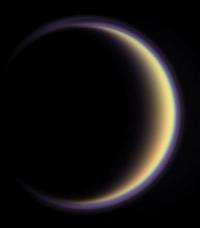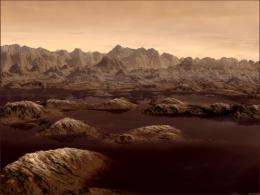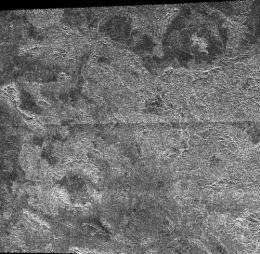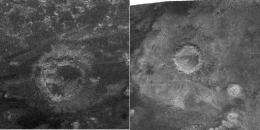Counting Titan's Craters

Impact craters found on Titan could help scientists determine the age of this Earth-like moon and its potential for life.
A new study in the journal Icarus provides the latest round-up of the number of impact craters found on Saturn’s moon Titan.
Between 2004 and December 2007, Cassini had surveyed 22 percent of Titan’s surface. Scientists analyzed images taken by the spacecraft’s high-resolution Radar Mapper instrument, and found 49 impact craters.
“Impact craters are created on every planet because of asteroids, comets and other debris that collide with their surfaces,” said Charles Wood, senior scientist at the Planetary Science Institute in Tucson, Az, and lead author of the study. “Analyzing impact craters is a standard technique to tell you the history of the world.”
Titan has been described by NASA as "one of the most Earth-like worlds" found to date. But it's no secret that Saturn’s largest moon is a very unfriendly place for life.
The main reason Titan seems to be unfit for life is because of its temperature. Temperatures on Titan, located approximately 800 million miles away from the Sun, hover around minus 290 F (minus 179 C). When it is that cold, water on the surface becomes as hard as rock, eliminating the liquid water that scientists believe is a precondition for the existence of life as we know it.
Why then are scientists still so preoccupied with studying this planetary body, requesting more missions and thus more funding? The answer lies in Titan’s similarity to early Earth.
“Titan is really remarkable because it is such an Earth-like planet,” said Wood.
Titan is giving scientists like Wood an opportunity to look back in time. Other than the absence of liquid water on the surface, the atmospheric conditions that exist on Titan today resemble the environment that probably existed on early Earth. Titan is the only planetary body in the solar system, other than Earth and Venus, to have a solid surface and a dense atmosphere. And like Earth, nitrogen makes up much of that thick, hazy atmosphere, with small amounts of methane.
Methane exists as a liquid, gas and solid at Titan’s freezing temperatures, and scientists believe it could be playing the role that water does on Earth.
“Some people say Titan is like a cold version of early Earth,” said Wood. “If it were warmer, you'd definitely think life existed there.”

Understanding the chemical processes on Titan may help scientists understand how life began on Earth billions of years ago.
But many questions still linger, and that is the reason scientists are so committed to studying this satellite of Saturn. The Cassini spacecraft’s radar instrument is uncovering some of the mysteries that lie beneath the thick hydrocarbon atmosphere that hides our view of Titan’s surface.
Cassini’s Count
Young impact craters are easy to identify because of their near-circular outlines, low rims, deep interiors and flat floors. But volcanoes can also create circular depressions that look very much like eroded impact craters.
“When you see a round (structure) in a new world, you have to think there are two likely origins: impact cratering or volcanism,” Wood said.
Scientists have fairly fool-proof methods for distinguishing craters created by volcanoes from those created by an impact. While no one knows much about the type of volcanic activity on Titan, scientists think volcanoes on Titan wouldn't expel hot-rock lava like on Earth. Instead, liquid water mixed with ammonia or other chemicals would probably ooze out of the volcano, and then freeze solid on the surface. Volcanoes also may be a source of the methane in Titan’s atmosphere.
Wood says there is strong evidence that most of the craters seen in these Cassini images were created by impacts.
“On about (22) percent of Titan, five of them looked very much like impact craters,” Wood said. “I don't think there would be any question.”
In this analysis, scientists identified the five "certain impact craters” to be the Ksa, Sinlap, Menrva, Afekan and Selk craters. The remaining 44 craters were classified as Class 2 (nearly certain impact craters) and Class 3 (probable impact craters).

“I think they did a good job given the nature of the data,” said Alfred McEwen, professor of planetary sciences and director of the Planetary Image Research Lab at the University of Arizona.
So far, Cassini images have revealed only about one fifth of Titan’s surface, and that is inadequate to make any definitive conclusions about the potential for any kind of life forms to exist on Titan. Wood says if they find that the surface of Titan is “very ancient,” that probably means chances of finding life would be less likely.
If a planetary body is heavily cratered, like Jupiter’s moon Callisto, it’s because the surface hasn’t been altered much by volcanic activity or atmospheric weathering. An asteroid or comet impact on such an inactive world leaves a crater that lasts for eons. But for an active planet such as Earth, impact craters tend to get buried or erased over time. The geological or atmospheric activity of a world may be related to its prospects for life. Since Titan has very few impact craters, scientists predict it may be an active moon with a very fresh surface.
In another recent study, Wood and a team of scientists looked at impact craters on an area of Titan known as Xanadu - what they describe as "the most unusual region on Titan." Xanadu, about the size of Australia, is a large bright area that scientists suspect may be made of water ice. Xanadu has more impact craters than any other region surveyed by Cassini so far, but the distribution of these craters appears to be very irregular. This means that the age of Xanadu varies depending on the location.

Right now, scientists don’t have enough data to make final conclusions about the age or activity of Titan’s surface, and that is why there is a need for a more complete look at the enigmatic moon.
“In the next seven years, the extended mission funded by NASA will continue to allow the radar instrument to reveal more of the surface of Titan,” Wood said. “Hopefully by the end of the mission, we will have seen about 50 percent of Titan's surface, finding more impact craters and clues to Titan’s history.”
McEwen hopes for an even better option.
“A new mission to Titan would be very nice, of course,” McEwen said. “We'd like to get much more complete remote sensing data. Now that we can understand Titan, we can design better instruments. There's much more information we'd like to have from the surface.”
Source: Astrobio.net, by Anuradha K. Herath


















